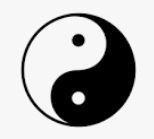In popular culture, many people are vaguely familiar with the Yin-Yang Symbol and some of its attributes, such as the yin darker side of the symbol relating to the feminine principle and the yang lighter side of the symbol relating to the masculine principle.

In virtually all schools of Feng Shui, there is exploration into the many manifestations of yin and yang aspects to our lives and surroundings. All of Chinese metaphysics and Chinese medicine relate to Yin-Yang Theory uniquely, with a lot of overlapping observations and conclusions.
Within the field of Feng Shui, we can label spaces that are dark, damp, quiet, cold and still as yin. We can also make a comparison of yang attributes to spaces that are bright, dry, noisy and hot. And one of the goals in balancing an environment is to make sure the spaces are not excessively yin or yang.
It might be a logical deduction that a “yin house” is a house that has excessive yin traits. And yet, the name “Yin House” refers specifically to a branch of Feng Shui that deals exclusively with the most yin environment of all: grave sites. This is just as ancient a practice in the area of Feng Shui as “Yang House” which deals with spaces for the living.
Yin House has its own set of rules and guidelines for diagnosing a grave site, and a practitioner cannot even begin to understand the implications of a grave site (on up to three generations of descendants) unless they have a working knowledge of classical Feng Shui. This includes Xuan Kong Fei Xing (Flying Star School) and Form School at the very least.
Based on the orientation of the grave and when the body is placed there, a Yin House is created that can affect the health, well-being, and fortunes of children, grand children and great-grandchildren of the deceased. The energy transmission will go from parent to child and not from sibling to sibling or spouse to spouse. Of course, your spouse’s yin house will affect children that you mutually share so there can be an indirect influence.
Yin House Theory maintains that the ground below can act as a conduit for energy to be passed, through the bones of the deceased, from the grave site to their living relatives. But many of the principles for what constitutes a good yin house are not necessarily obvious or known without training. For example, a grave site is about as yin as you can get, death resides there. One might think that it is a lovely choice to have a plot under a shady tree in the cemetery. And yet, that would only make the grave site even more yin.
The goal is to bring a little more yang energy to the area, so a plot right out in the open space, receiving plenty of light is actually the better choice. Those kinds of principles are easy to grasp and plan for. What is not so easy is planning for the time when a person will actually “move in” to their yin house. Just like Yang House, using the Xuan Kong methodology where houses are created within 20 Year eras, you can plan to occupy a plot in a certain direction and in a certain time frame, but unless one knows what year they will die, there could be some problems in long range planning.
In many cultures, whole families will be laid to rest in one big family plot. In this case, the choices are greatly diminished as the orientation is mostly fixed. For example, grand pa could have been laid to rest in 1974 (Period 6), while dad was laid to rest along side in 2004 (Period 8) and space left for the next generation, without knowing what Period it will end up being. These time frames alone can make the difference between a good yin house and a bad yin house and how it may effect future generations. Obviously, the study and observation of this branch of Feng Shui spans over many decades, compared to the Yang House feedback which can be immediate.
Yin House has many aspects to consider including the larger environment of the cemetery, the road courses within the cemetery, the land quality and land levels, nearby natural features such as mountains or water, the orientation of the plot, and even whether the head stone is placed flat on the ground or positioned upward, perpendicular to the ground. The birth year of the person to be laid to rest is also factored into the calculation for the best possible grave site and no doubt this type of service is requested with very little advance notice some of the time. As well, questions inevitably come up regarding cremation and whether or not there is any influence from ashes, be they buried, stored or dispersed.
Author: Kartar Diamond
Company: Feng Shui Solutions (R)
From the Feng Shui Blog Series
